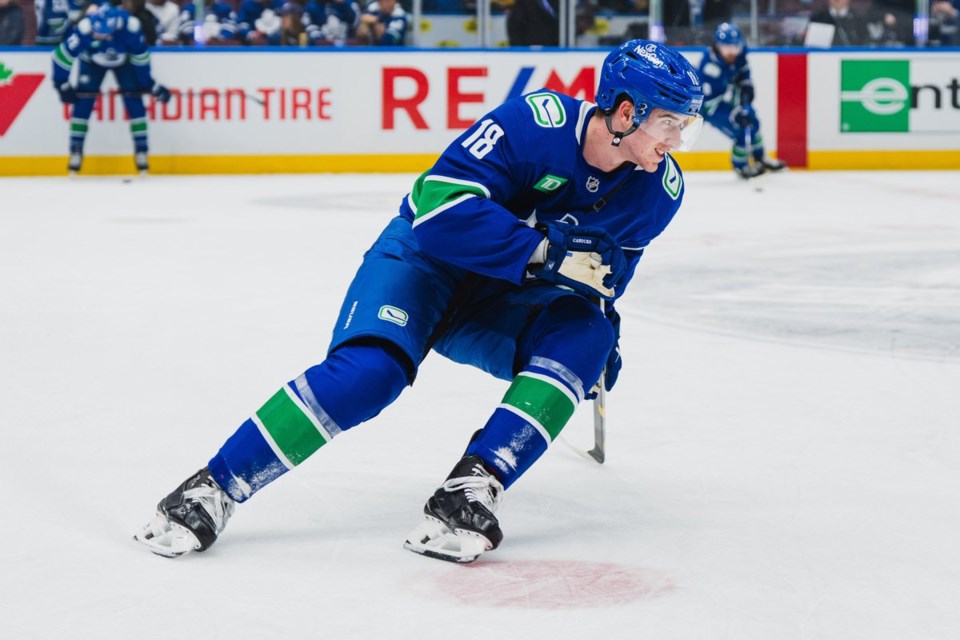When the Vancouver Canucks traded J.T. Miller, they needed to make sure the return they got for him lasted beyond this season.
The two players they received from the New York Rangers in the Miller trade, Filip Chytil and Victor Mancini, are both signed beyond this season, with Mancini still a restricted free agent when his contract expires in 2026.
The Canucks flipped the Rangers’ first-round pick to the Pittsburgh Penguins, however, for two pending unrestricted free agents: Marcus Pettersson and Drew O’Connor. Not wanting either player to be a rental for just this season, the Canucks moved quickly to re-sign both players, getting Pettersson’s deal done less than a week after acquiring him.
On Tuesday, the Canucks’ management team showed they weren’t taking a break during the 4 Nations Face-Off, re-signing O’Connor to a two-year deal. The contract also includes some trade protection, with a modified no-trade clause that allows him to name 12 teams to which he cannot be traded.
O’Connor’s contract carries a cap hit of $2.5 million per year, placing O’Connor firmly in third-line territory. That fits with the minutes he’s played in his career. He averaged 15:45 in ice time per game for the Pittsburgh Penguins last season and is averaging 14:34 per game this season.
AFP Analytics projected a two-year contract worth around $2.07 million per year, so a $2.5 million cap hit is arguably a slight overpay, though far from an egregious one. It’s certainly a significant raise for O’Connor, who had a $925,000 cap hit on his last two-year deal.
The contract is comparable to the one Danton Heinen signed with the Canucks this past offseason. Heinen signed a two-year contract worth $2.25 million per year, which represented 2.56% of the salary cap at the time. O’Connor’s contract takes up 2.62% of the salary cap.
O’Connor is three years younger than Heinen but has less of a track record in the NHL, only fully making the league just last season. Across five seasons, he has played a total of 214 games in the NHL, four of them with the Canucks.
Last season, O'Connor was a capable energy forward for the Penguins. His underlying numbers were solid, with a 51.4% corsi and a 50.5% expected goals percentage, indicating that the Penguins outshot and out-chanced their opposition with O'Connor on the ice at 5-on-5. He was also a solid penalty killer last season, with the third-lowest rate of unblocked shot attempts against and third-lowest rate of goals against among Penguins forwards.
O'Connor's has been about as good this season, with similar results on the penalty kill and a 51.6% corsi and 51.4% expected goals percentage. The difference is that O'Connor has been absolutely buried by the bounces, with the Penguins getting outscored 33-to-19 at 5-on-5 with O'Connor on the ice despite his positive underlying numbers.
Unsurprisingly, O'Connor's PDO — a statistic that combines on-ice save percentage and shooting percentage as an approximation of luck — is among the lowest in the NHL. The league average is 1.000; O'Connor's PDO is .961. Assuming that number regresses to the mean, O'Connor should look a lot better in the future than he's looked this season.
The Canucks are banking on O’Connor thriving in Vancouver, as he plays exactly the type of game that general manager Patrik Allvin likes: fast-paced and heavy. It’s been clear from his few games with the Canucks that O’Connor is one of the fastest players on the team, with an ability to carry the puck in transition and gain the offensive zone with possession.
Combining that speed with his 6’4”, 209 lbs frame and it is readily apparent what the Canucks like about O’Connor.
They also believe that O’Connor may have a little bit more offence in his game than what he’s shown so far. O’Connor managed 16 goals and 33 points in 79 games last season, which is decent enough for a third-line winger, but the Canucks hope that he can be a complementary forward in a top-six role.
In recent games, O’Connor has lined up with Chytil and Brock Boeser, bringing his speed and forechecking to the Canucks’ second line. It’s a combination that has looked dangerous and dynamic but it remains to be seen if O’Connor can maintain that level of play.
For what it’s worth, O’Connor has been a point-per-game player in the AHL, putting up 27 goals and 73 points in 73 games. If he can translate a little bit more of that offence to the NHL, his contract could look like a steal.
If not, O’Connor should still be worth his contract in a third-line role as a forechecker and penalty killer.



